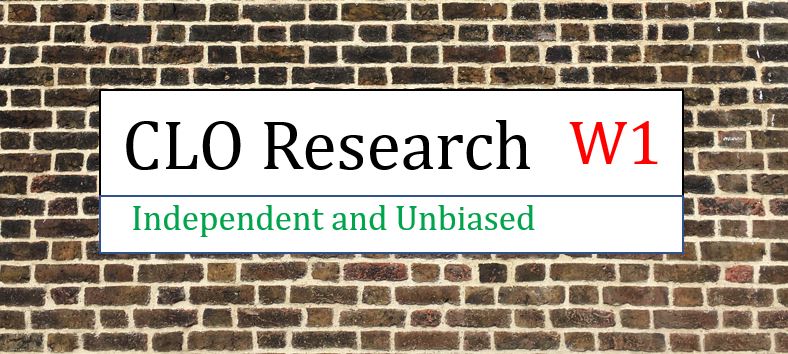The relationship between the pricing of CLO tranches and the loan market can be an intimate one. CLO tranches trade on the back of the loan market.
In a matter of just two weeks since the onset of the coronavirus crisis, a loan price of 85 has become the new par and 75 the new 90. Unsurprisingly, CLO deals are now suffering from less than 100% MVOC at the BBB-B levels and negative equity NAVs.
The graph below shows the EU CLO EQ NAV move from 2nd March to 18th March. All 2014 to 2019 deals (excluding deals that exited their reinvestment period last year) are now deep in the negative territory. Please see the previous blog, determining top-tier CLO managers, for more details on the various commonly used metrics and their weaknesses, including CLO EQ NAV. 
Source: LCD, an offering of S&P Global Market Intelligence, LPC, Intex, CLO Research Group
2014 – 2019 EU CLO deals

Can CLO Equity Survive The Coronavirus Pandemic?
The typical reaction in the current, unprecedented times is to stress test CLO deals. One could come up with all kinds of scenarios, but it is always difficult to assign a probability to each stress scenario. According to Moody’s, the global speculative default rate would go up to 9.7% by the end of 2020 under a more pessimistic scenario (published on the 10th March). A week seems like ages ago in today’s environment.
While the 2008 financial crisis is different, it is still interesting to revisit how CLO equity rode out that crisis for reference. To do that, we look at how the underlying loan collateral had performed during that time. S&P European All Loans Index fell to a price of 59-60 and hovered around that level for several months in late 2008 and early 2009 before making a steady recovery.
2007 EU CLO Cohort Study (sample size of 30 deals)
- Pre-crisis EU CLO deals (2007) had an average of 6.6 years reinvestment period.
- Assuming that 2007 EU CLO deals tracked the performance of the S&P European leveraged loan index, the average gross annualised return was 3.9% (range from 3.4% to 4.7%) over the CLO reinvestment periods. Please see the last blog for more details on the average alpha of EU CLO 2017 deals for reference.
- Annualised collateral return (net of management fee) minus cost of funding = 0.65% (-0.22% to 1.88%) unleveraged basis

Source: LCD, an offering of S&P Global Market Intelligence, LPC, Intex, CLO Research Group
- It is worthwhile to note that while pre-crisis CLO deals* (2007) had an average of 6.6 years reinvestment period, CLO managers managed to extend the ‘reinvestment period’ by 0.9 years on average, post reinvestment period, before paying down the liabilities significantly (over 20% of the initial liability balance).
- Over the extended period, the average gross annualised return improved to 4.13% (range from 3.88% to 4.61%) and WACC decreased from 2.73% to 2.63% p.a.

Source: LCD, an offering of S&P Global Market Intelligence, LPC, Intex, CLO Research Group
- Annualised collateral return (net of management fee) minus cost of funding = 0.91% (0.27% to 1.82%) unleveraged basis
Arbitrage would be further enhanced from the base 0.9% on an unlevered basis for those managers who outperformed the index.
Conclusion
The long-term non-recourse CLO structure has been demonstrated to work well across credit cycles (even prolonged ones).
From the experience of the above cohort of 2007 EU deals, it highlighted the importance of entering into a credit cycle with a decent length of reinvestment period. The longer the reinvestment period, the more valuable the time value of money. Even if the reinvestment period is short, the prolonged crisis might lead to a low loan portfolio prepayment rate, thereby extending the deal’s life (but cost of funding would rise faster for prepaying deals). If CLO equity did well in general, one would not expect to see any par impairment at the rated debt levels.
While post-crisis CLO deals have slightly shorter reinvestment periods, investors could reset and extend the life of these deals – a unique feature that was non-existent in pre-crisis CLO deals. A caveat is that the CLO market needs to be open for business.
Disclaimers
The information, research, data, research related opinions, observations and estimates contained in this document have been compiled or arrived at by CLO Research Group, based upon sources believed to be reliable and accurate, and in good faith, but in each case without further investigation. None of CLO Research Group or its service providers, their directors or authorised personnel make any expressed or implied presentation or warranty, nor do any of such persons accept any responsibility or liability as to the accuracy, timeliness, completeness or correctness of such sources and of the information, research, data, research related opinions, observations and estimates contained in this document. All information, research, data, research related opinions, observations and estimates contained in this document are in draft form as at the date of this document and remain subject to change and amendment without notice. Neither CLO Research Group nor any of their third-party providers shall be subject to any damages or liability for any errors, omissions, incompleteness or incorrectness of this document. This article is not and should not be construed as an offer, or a solicitation of an offer, to buy or sell securities and shall not be relied upon as a promise or representation regarding the historic or current position or performance of any of the deals or issues mentioned in it.









